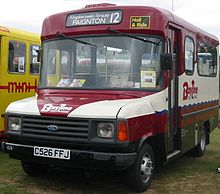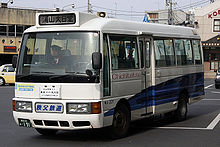- Minibus
-
 Hino Poncho front-engined low-floor minibus
Hino Poncho front-engined low-floor minibus Toyota Coaster hospital minibus in Hong Kong
Toyota Coaster hospital minibus in Hong Kong
A minibus or minicoach is a passenger carrying motor vehicle that is designed to carry more people than a multi-purpose vehicle or minivan, but fewer people than a full-size bus. In the United Kingdom, the word "minibus" is used to describe any full-sized passenger carrying van. Minibuses have a seating capacity of between 8 and 30 seats. Larger minibuses may be called midibuses. Minibuses are typically front-engined step-entrance vehicles, although low floor minibuses do exist.
Contents
Usage
Minibuses are used for a variety of reasons. In a public transport role, they can be used as fixed route transit buses, airport buses, flexible demand responsive transport vehicles, share taxis or large taxicabs. Accessible minibuses can also be used for paratransit type services, by local authorities, transit operators, hospitals or charities. Private uses of minibuses can include corporate transport, charter buses, tour buses. Schools, sports clubs, community groups and charities may also use minibuses for private transport. Individual owners may use reduced seating minibuses as cheap recreational vehicles.
Types
By size, microbuses are minibuses smaller than 8 metres (26 ft 3 in) long. Midibuses are minibuses bigger than microbuses but smaller than plenibuses (full-size buses).
There are many different types and configurations of minibuses, due to historical and local differences, and usage. Minibus designs can be classified in three main groups, with a general increase in seating capacity with each type:
- Van conversions. Simple, optional extras
- Body builds
- Purpose built
Van conversions
 Ford Transit van factory minibus model
Ford Transit van factory minibus model
The most basic source of minibus is the van conversion, where the minibus is derived by modifying an existing van design. Conversions may be produced completely by the van manufacturer, sold as part of their standard model line-up, or be produced by specialist conversion companies, who source a suitably prepared base model from the van manufacturer for final completion as a minibus.
Van conversions involve adding windows to the bodywork, and seating to the cargo area. Van conversion minibuses outwardly look the same shape as the parent van, and the driver and front passenger cabin remains unchanged, retaining the driver and passenger doors. Access to the former cargo area for passengers is through the standard van side sliding door, or the rear doors. These may be fitted with step equipment to make boarding easier. Optional extras to van converted minibuses can include the addition of a rollsign for transit work, and/or a full-height walk-in door, for passenger access to the former cargo area. For public transport use, this door may be an automatic concertina type. For other uses, this may be a simple plug style coach door. Depending on the relevant legislation, conversions may also involve wheelchair lifts and tachograph equipment. A van conversion with a passenger area in the front and a storage area in the back, behind a fixed bulkhead, is called a splitter bus.
Examples of vans used for these conversion minibuses are:
Body builds
Another method of building a minibus is for a second stage manufacturer to build a specific body for fitting to a semi-completed van or light truck chassis. These allow a higher seating capacity than a simple van conversion. Often, the second stage manufacturer is a bus manufacturer.
In a body-on-chassis minibus, a cabin body is installed on a van or light truck chassis encompassing the drivers area. These designs may retain some outward signs of the original van, such as the hood and grill. Other designs are visually a complete bus design, and it is merely the chassis underneath that is from the van design.
The body-on-chassis approach gives the advantage of higher seating capacity, or more room for passenger comfort, through a larger cabin area. There is also the advantage of being able to have the drivers seat positioned in a small cubicle, next to the main passenger entrance, allowing the driver to collect fares in a transit bus role.
Examples of body built minibuses are:
- Busette (cut away chassis)
- Optare CityPacer (visually complete bus based on a van chassis)
Examples of vehicles used for this type of minibuse are:
- Ford Transit
- Freight Rover
- Isuzu Elf locally built as the NQR bus
Purpose built
Nissan Civilian purpose built minibus
A next generation approach to the van-derived or cutaway chassis approach, is for manufacturers to produce an integral design, where the whole vehicle is purposely designed and built for use as a minibus. This is usually done by an integral bus manufacturer, although large automotive groups also produce their own models. These designs are often available in long high capacity versions, and may attract different designations, such as midibus, or light bus.
Examples of purpose built minibuses are:
- Hino Liesse
- Isuzu Journey
- MCW Metrorider (also termed a midibus)
- Nissan Diesel RN
- Nissan Civilian
- Mitsubishi Fuso Rosa
- Toyota Coaster
Low floor minibuses
 Hino Poncho rear-engined low-floor minibus
Hino Poncho rear-engined low-floor minibus
Following the invention of low-floor technology, some low-floor purpose built minibuses have been created. Some offer a low floor access through a centre door. Some short versions of low floor midibuses are sometimes also called minibuses.
- Orion Bus Industries "Orion II"
- Mitsubishi Fuso Aero Midi ME
- Optare Solo (termed a midibus)
- Optare Alero
- Hino Poncho (1st generation front-engined, 2nd rear-engined)
- Nissan Diesel RN (some models have a low floor middle entrance)
- Bluebird Tucana (full length low flat floor from Bluebird Vehicles Ltd)
- Bluebird Auriga (tri-axle design)
Driving license
Some countries may require an additional class of driving licence over a normal private car licence, and some may require a full commercial driver's license. The need for such a license may depend on:
- Vehicle weight or size
- Seating capacity
- Driver age
- Intended usage
- Additional training (such as the Minibus Driver Awareness Scheme in the UK)
Gallery
-
Volkswagen Type 2 "microbus"
-
Orion Bus Industries "Orion II" minibus
-
Optare Alero integral low floor minibus
-
Nissan Diesel RN partially low floor light bus
See also
- Public light buses - minibuses in Hong Kong
- Short bus - school buses smaller than full-size buses
- Pesero - minibuses operating as regular buses in Mexico, especially in Mexico City.
- Marshrutka - routed taxicabs operating in Eastern Europe and the former Soviet Union
- VW Microbus
- List of buses
References
Buses Configuration List of buses · Articulated bus · Bi-articulated bus · Coach · Double-decker bus · High-floor · Lowbridge double-deck bus · Low-floor bus · Midibus · Minibus · Multi-axle bus · Open-top bus · Single-decker bus · Trailer bus · Truck busSpecial uses Advert bus · Airport bus · Armoured bus · Battle bus · Campaign bus · Party bus · Police bus · School bus · Sleeper bus · Transit bus · Training bus · Tour bus · Trolley-replica busTechnologies Manufacturing Bus manufacturing · Bus manufacturersCategories:- Types of buses
- Minibuses
Wikimedia Foundation. 2010.

















